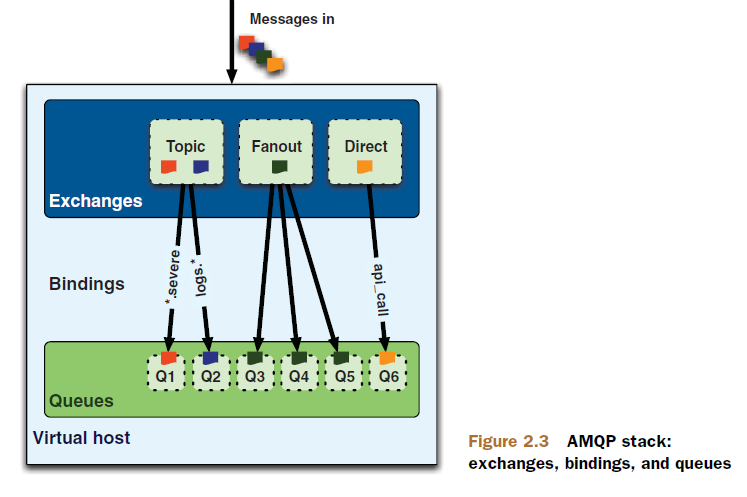《RabbitMQ in action》
2014-09-10 13:20 youxin 阅读(467) 评论(0) 编辑 收藏 举报Producers create messages and publish (send) them to a broker server (RabbitMQ).What’s a message? A message has two parts: a payload and a label. The payload is the data you want to transmit. It can be anything from a JSON array to an MPEG-4 of yourfavorite iguana Ziggy. RabbitMQ doesn’t care. The label is more interesting. It describes the payload, and is how RabbitMQ will determine who should get a copy of your message. Unlike, for example, TCP, where you specify a specific sender and a specificreceiver, AMQP only describes the message with a label (an exchange name andoptionally a topic tag) and leaves it to Rabbit to send it to interested receivers based on that label. The communication is fire-and-forget and one-directional. We’ll getmore details about how RabbitMQ interprets the label later when we talk about exchanges and bindings. For now, all you need to know is that producers create messagesand label them for routing (see figure 2.1).
Consumers are just as simple. They attach to a broker server and subscribe to a
queue. Think of a queue as a named mailbox. Whenever a message arrives in a particular
mailbox, RabbitMQ sends it to one of the subscribed/listening consumers. By the
time a consumer receives a message, it now only has one part: a payload. The labels
attached to the message don’t get passed along with the payload when the message is
routed. RabbitMQ doesn’t even tell you who the producer/sender was.
, if you need
to know specifically who produced an AMQP message, it’s up to the producer to
include that information as a part of the message payload.
First, you need to understand queues. Conceptually, there are
three parts to any successful routing of an AMQP message: exchanges, queues, and
bindings. The exchanges are where producers publish their messages, queues are
where the messages end up and are received by consumers, and bindings are how the
messages get routed from the exchange to particular queues.





【推荐】国内首个AI IDE,深度理解中文开发场景,立即下载体验Trae
【推荐】编程新体验,更懂你的AI,立即体验豆包MarsCode编程助手
【推荐】抖音旗下AI助手豆包,你的智能百科全书,全免费不限次数
【推荐】轻量又高性能的 SSH 工具 IShell:AI 加持,快人一步
· 基于Microsoft.Extensions.AI核心库实现RAG应用
· Linux系列:如何用heaptrack跟踪.NET程序的非托管内存泄露
· 开发者必知的日志记录最佳实践
· SQL Server 2025 AI相关能力初探
· Linux系列:如何用 C#调用 C方法造成内存泄露
· 无需6万激活码!GitHub神秘组织3小时极速复刻Manus,手把手教你使用OpenManus搭建本
· Manus爆火,是硬核还是营销?
· 终于写完轮子一部分:tcp代理 了,记录一下
· 别再用vector<bool>了!Google高级工程师:这可能是STL最大的设计失误
· 单元测试从入门到精通
2013-09-10 判断栈和堆的生长方向
2013-09-10 百度面试题:求绝对值最小的数
2012-09-10 设计模式之装饰者模式